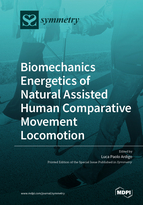Biomechanics Energetics of Natural Assisted Human Comparative Movement Locomotion
A special issue of Symmetry (ISSN 2073-8994). This special issue belongs to the section "Life Sciences".
Deadline for manuscript submissions: closed (15 December 2020) | Viewed by 19510
Special Issue Editor
Interests: biomechanics
Special Issues, Collections and Topics in MDPI journals
Special Issue Information
Dear Colleagues,
Movement and locomotion have always been key activities for all animals, being so related to the most crucial life functions: retrieving food, facing environmental issues and mating. Thus, humans fully developed complex upper arms movements and bipedal gaits in order to move and locomote. To further enhance their performance, they started inventing smart passive mechanical tools. This need arose from both intrinsic limitations of their muscles-joints-bones system and metabolic power availability. Newly invented devices were mainly introduced in order to cope with such constraints.
How symmetrical/asymmetrical are most performing/economical human-powered assisted locomotion modes on land, water, and air to date; how did passively assisted locomotion and/or movement (for catching, manipulating, carrying, etc.) evolve over history in terms of symmetry degree; and how symmetrically do man-passive tool complex best adapt to extreme environmental conditions (viz. different gradients, surfaces, media, etc.) are only some of the potential topics regarding symmetry and biomechanics and energetics of passively assisted human movement and locomotion.
The aim of this Special Issue is to advance knowledge regarding symmetry and biomechanics and energetics of passively assisted human movement and locomotion.
Dr. Luca Paolo Ardigo
Guest Editor
Manuscript Submission Information
Manuscripts should be submitted online at www.mdpi.com by registering and logging in to this website. Once you are registered, click here to go to the submission form. Manuscripts can be submitted until the deadline. All submissions that pass pre-check are peer-reviewed. Accepted papers will be published continuously in the journal (as soon as accepted) and will be listed together on the special issue website. Research articles, review articles as well as short communications are invited. For planned papers, a title and short abstract (about 100 words) can be sent to the Editorial Office for announcement on this website.
Submitted manuscripts should not have been published previously, nor be under consideration for publication elsewhere (except conference proceedings papers). All manuscripts are thoroughly refereed through a single-blind peer-review process. A guide for authors and other relevant information for submission of manuscripts is available on the Instructions for Authors page. Symmetry is an international peer-reviewed open access monthly journal published by MDPI.
Please visit the Instructions for Authors page before submitting a manuscript. The Article Processing Charge (APC) for publication in this open access journal is 2400 CHF (Swiss Francs). Submitted papers should be well formatted and use good English. Authors may use MDPI's English editing service prior to publication or during author revisions.
Keywords
- symmetry
- physical activity
- metabolic expenditure
- motor control
- sport technology
- testing
- training






